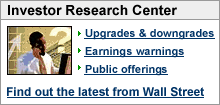|
Too much, too fast for the stock market?
The early '06 stock surge has left some analysts worried that the bull has gotten ahead of itself.
NEW YORK (CNNMoney.com) - Not so fast. Sure, stocks are off to a fast start in 2006 and in the past fast Januarys have often meant good things for the full year. But it's a bit early to be declaring an upbeat year for the market.
"It's been a constructive start to the year," said Subodh Kumar, chief U.S. investment strategist at CIBC World Markets. "But the runup has been too fast. The momentum we've seen in the first week is unsustainable." Kumar likes the fact that the leadership has changed from energy and defensive stocks late last year to growth issues, notably tech stocks. He also thinks that a probable end or pause to Fed rate hikes, and further earnings growth this year are positives that will support stocks. But he thinks that analysts' earnings forecasts for the fourth quarter and the year ahead are high, and are bound to come down as the year progresses. Already Dow stocks DuPont (Research) and Alcoa (Research) have offered disappointing news on the fourth quarter. Kumar thinks fair value for the S&P 500 is around 1,300, which is not far from where it ended Tuesday's session. And that's what seems to be a big part of the problem. Namely, that in the first five trading days of the year, the S&P 500 has already chalked up most of the gains that many analysts have been forecasting for the full year. Most of the analysts consulted for this story said they're looking for the S&P 500 to return 5 to 7 percent this year, including dividends. But the return is already running at more than 3.5 percent for the first seven sessions of the year, versus a total return of 4.9 percent last year for the index of 500 blue chips. That doesn't mean that stocks won't beat expectations. But it does mean that a sideways, choppy market for a good part of 2006 is a real possibility. "I definitely think the market is heading in the right direction," said Ben Halliburton, chief investment officer at Tradition Capital Management. "I also think there are a lot of challenges." He said that it's an interesting dilemma that what is challenging the market right now is also a big part of what makes stocks so attractively valued relative to other assets -- namely higher oil prices, the ongoing impact of the war in Iraq and the impact of unusually low long-term interest rates in the bond market. Good January, good year?
According to the Stock Trader's Almanac, there are two events in January that can be good predictors of how the market will perform for the full year. The first looks at how the S&P 500 does in the first five trading sessions of the year, the second at how the broad blue-chip index does for the month of January. Of the 35 years in which the S&P 500 posted a gain in the first five days of the year, 30 were followed by full-year gains. That's pretty good for an indicator. But a better predictor is the overall January barometer, which says that as the S&P 500 goes in January, so goes the year. Since 1950, that's been true more than 90 percent of the time, according to the Almanac. Even when you add in flat Januarys and flat years, it's accurate 78 percent of the time. But Almanac editor Jeffrey Hirsch said much of that doesn't apply in "mid-term election years" like the one we're in now, noting that the second of the four years in a presidential term is typically the worst in the cycle. Only six out of the last 14 mid-term years have been up years for the S&P 500 regardless of what happened in January, he noted. "I think what we've seen so far this year is more of a last gasp (after the late 2005 rally) and I expect a major buying opportunity later in 2006," Hirsch said. That could come after the market hits bottom sometime in the second or third quarter, he added. Hirsch said that the mid-term year is typically a real host of bear market bottoms, and that nine of the last 14 bear-market bottoms happened in mid-term years. The upside of that is that the market could rise again in the fall, recovering from any losses and managing small gains by the end of the year. The Fed and other factors
The rally so far has been largely predicated on bets that the Federal Reserve will halt its 18-month interest-rate hiking campaign sometime soon, an assessment investors made after the recent release of the minutes from the last Fed policy meeting. Fed funds futures are factoring in another quarter-point hike at the January meeting, the last to be headed by Chairman Alan Greenspan. The bets are roughly 50-50 as to whether there will be another rate hike in March, the first meeting with incoming Fed chief Ben Bernanke. Investors seem to be confident that if the Fed should stop raising rates, that would be stimulative to the economy, along with other factors, such as strong demand for U.S. goods, said Stephen Leeb, president at Leeb Capital Management "The wild card is inflation," Leeb said. "Right now, the cup is half full, which is good, but the Fed also said in its meeting notes that it was concerned about inflation in 2006." Among the signs of growing pricing pressure, Leeb points to service sector inflation, a rise in the core consumer price index, oil prices back near record highs and gold prices at 25-year highs.
"It's a great start to the year," Leeb added, "but you just can't go to bed at night saying these things aren't out there." |
|





